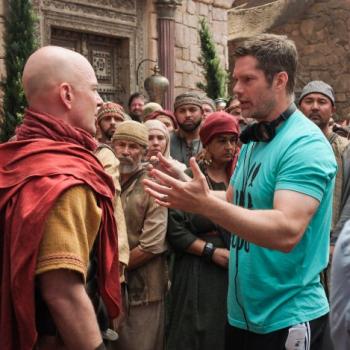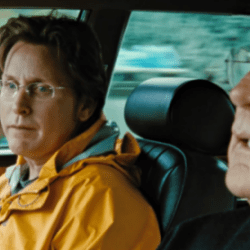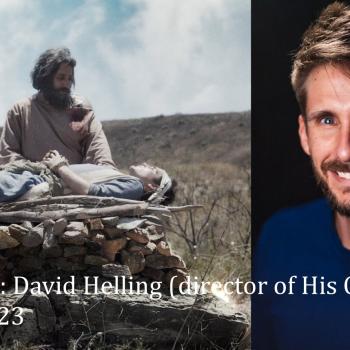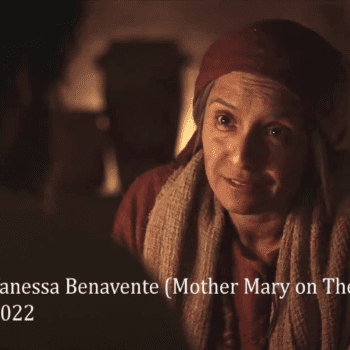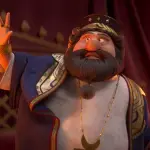
My interview with John A. Davis, director of The Ant Bully, is now up at CT Movies. I may post a longer version here in a few days.
JUL 29 UPDATE: Here it is, the full unexpurgated interview!
– – –
By Peter T. Chattaway
The creator of Jimmy Neutron: Boy Genius has already taken his imagination up, up, up into space, so it’s kind of fitting that the movie he made as his follow-up should point in the exact opposite direction — down, down, down into the very soil we walk upon.
The Ant Bully, based on a book by John Nickle, concerns a boy named Lucas who is picked on by the neighborhood bully, and who vents his frustrations by picking on the ant colony in his front yard. The ants don’t take kindly to this, so they devise a way to shrink the boy down to their size — an experience that teaches Lucas a lesson or two.
Director John A. Davis got his start in stop-motion animation, but it wasn’t long before he caught the digital bug. In 1997, he wrote and directed Santa vs. the Snowman, a TV special that was later expanded for IMAX 3D theatres; and in 1999, he served as the animation director for another Christmas special, Matt Groening’s Olive, the Other Reindeer. And then came Jimmy Neutron, which was one of the first three films to be nominated for the Oscar for Best Animated Feature. (The others were Shrek, which won, and Monsters, Inc.)
We talked to Davis about his history in animation, other bug movies, and, of course, The Ant Bully.
I want to talk first of all about your background in animation. The press kit mentioned that you came to digital animation from stop-motion.
John A. Davis: Yeah, I had a keen interest in stop-motion, which is what led me to start making films when I was a kid. I saw an animated film at a festival. The film was called Icarus, and it was a clay animation short, and while I was watching it, I had, like, a little revelation. I figured out how they were doing it — I was like, “Oh, I know how they’re doing this!” — and so I got excited, and when I got home, I got my parents’ home movie camera and started animating my action figures at home. Move ’em a little bit, take a frame, move ’em a little bit more, take a frame, get the film back, and I was really excited. “Wow, they’re dancing around on their own!” I was just sort of hooked.
And by the time I got to high school, I started a film club, and we would raise money with bake sales and car washes and things like that, and raise money and make movies! And so I just sort of kept going, and majored in film in college, and started my own business in 1987 with Keith Alcorn, who I was working with at the time at a company that had just gone out of business. And so we started DNA Productions out of my apartment in Dallas, just the two of us.
Was DNA involved in digital animation from the beginning, or did it cover multiple kinds of animation?
Davis: At the time, I was doing a lot of stop-motion mixed with live action on all my student films in college, and then when I got out and got into the workplace, for a couple of years I was working at this company, K&H;, and I was running their animation department and optical printing department. So I would be shooting animation on their animation camera rig — and this is all, like, old-school film stuff — so I was shooting a lot of 2-D cel-type animation, and also a lot of motion graphics and stuff that was really big in the ’80s. And my partner, Keith, had an art background, and would draw and design characters. So we kind of teamed up, and he would draw and design characters, and I would do the camerawork; and I continued to do some stop-motion animation and build miniatures and do stuff in my garage. But when CG started to come on the scene, I saw it as a way to do better stop-motion, because I was always limited by what I could build in my garage and how many lights I could afford to rent — and with CG, I had unlimited real estate and as many lights as I wanted, so I kind of had a keen interest in it.
How old were you when you saw Icarus?
Davis: I think I was, like, 14 or so.
I was 11 or 12 when I was making stop-motion cartoons with my Lego toys.
Davis: Oh, wow, that’s even earlier!
But I didn’t last anywhere near as long as you did, because I got distracted by video cameras and you couldn’t do animation with video, at least not then.
Davis: Right, right.
And even that didn’t last terribly long. Now, you mentioned the action figures, and I think, “Wow, isn’t that cool to think that that’s my action figure that’s really moving,” whereas now, with CGI, nothing’s real, it’s all just images on a screen. Do you miss that sense of connection to the physical?
Davis: Yeah, actually, there is that part of it that I miss. You miss being able to hold them in your hands, and just the physicality of it is really cool. But the upside, to me, just far outweighs the downside, because with CG you’ve just got so much more control, and so much more power that you can bring to the screen for the time and money spent, I think. And you can really rehearse the performance of the animation and add levels of detail and texturing and things and have a much bigger canvas. You can do those things in stop-motion, but it would require huge amounts of miniature work and much longer, and probably much bigger budgets, really.
Do you find that with CG there is a temptation to go almost too big, to exploit the opportunities as it were, now that the limitations aren’t there?
Davis: That’s one of the things that I tend to talk a lot about, too. Since you can pretty much do anything, you have to be careful not to get too excessive, and make sure that you maintain a sense of dynamics in your film, in terms of your colour palette and your camera and your story. In everything, you need ups and downs, and if you stay in any one place too long, it gets static — and even action scenes, if they’re too active, too long, it becomes static, and it starts to become monotonous.
So things like CG, where you can do anything with the camera — you can just fly the camera around things — directors that haven’t really done it before, they kind of fall in love with the idea that they can do that, and typically I’ll notice that a lot of times they keep the camera flying around constantly, and what happens is you lose that dynamic of being able to keep the camera still for the quieter moments, and then when the action kicks in, you’ve got some place to go and the camera can become very active and you can get really creative with what you do with it, but you have to hold back so that you have somewhere to go. And also, the same can be said with the electric colour palette. You want to keep your colours kind of toned down and muted for scenes that are more stoic and sombre, and then when things become more active or excited, then you get more saturated colours, and again, dramatically, you’ve got somewhere to go.
Your background on stop-motion gives you a perspective on digital animation. Toy Story came out 11 years ago. Do you find, with people who are just entering the field now, professionally, is it the case that they know nothing but digital, and they don’t have that perspective? Or do you still get the sense that people coming into the business have that broader sense of the different kinds of animation, and a more multidisciplinary background?
Davis: I think it’s starting to get better now, but for a while, when CG was first sort of popular — after Toy Story came out, it kind of opened the door for these films to be made and studios were jumping on the bandwagon — I saw a lot of animation schools pop up across the country, and I would get demo reels from kids that were coming out of those schools looking for work, but the problem was that those schools were not teaching the principles of animation, they were teaching software. They thought, “That’s how you become an animator, you learn the software.” It’s like, nope! All that is is just a paintbrush, you’re going to have to learn how to paint. I think eventually they came to learn that, so that they’ve gotten a lot better. But I think that what’s needed is an overall sense of filmmaking, so that even if you’re going to specialize in any one particular area, which is what you’ll typically wind up doing, you know kind of the idea behind how all the pieces fit, which is really important.
I read somewhere that there were something like 14 major cartoons coming out this year. When Jimmy Neutron came out five years ago, the field didn’t seem quite so crowded at the time, and in just five years, suddenly everybody’s making cartoons and they’re virtually all digital. Do you feel the marketplace is more crowded now?
Davis: There’s definitely more animated product out there. But to me, I tend to look it as another medium for delivering content, for delivering stories. And as long as you’re not telling the same story over and over again, I think it’s great. Case in point, right now it doesn’t get any more crowded than when we are premiering here. We’ve got Monster House this weekend, and us next weekend, and Barnyard the weekend after that. So it’s like, boom boom boom, three CG films right in a row. And I haven’t seen Monster House or Barnyard, but my sense is that our movies are very different from one another. Monster House looks like a horror film —
A Halloween film, yeah.
Davis: Yeah, very scary, a lot of scares. And then Ant Bully is more of an action-adventure film. And then Barnyard, I think, is more of a zany comedy. So I think they are three different types of stories and different types of films. And if they’re all good movies, then hopefully they’ll find an audience and be rewarded. But again, I think animation is just another medium for telling a story, and not necessarily thinking of it like, “Oh, we’ve got too many animated films,” because it would be like saying, “We’ve got too many live-action films.”
How did you feel about the fact that, last year, there were two major stop-motion films, Corpse Bride and Wallace & Gromit? Did you pine to go back to that at all?
Davis: No, I’ve just really been hooked on CG, and I really like the process, and it’s very liberating, in a way. For example, I don’t do as much hands-on as I used to — I used to do animation and now I just write and direct and produce — but what I do do is I still do pre-viz work, and I’ll do some of the 3-D animatics, especially for my action set-pieces, shot planning. So I did several hundred shots for our first animatics, just planning out the shots, so I’ll have my 3-D software running on my laptop and I’ll sit at home on my couch and watch movies, watch TV, and then I’ll be working on my shots, just kind of planning camera moves and rehearsing things, and, “Wow, this would be really cool if we started here and did this,” and that kind of stuff.
It’s been about eight years since Antz versus A Bug’s Life. When you decided to make this story, was there any concern about retreading that ground, as it were?
Davis: Absolutely. The project started after Jimmy Neutron came out. I was looking for the next project, and Tom Hanks sent the book to me, because The Ant Bully is based on a children’s book, sort of a picture book. And he was reading it to his son Truman one night, and he thought, “Hey, this might make kind of a good movie.” So he was a fan of Neutron, and really liked it, and he sent the book to me to see if I had a take on it. But yeah, I thought about it for a few days, and thought, “Aw, I’ve seen a couple of CG ants movies recently, maybe I could do it with bees or roaches or something.”
But really, the needs of the story dictated that it was really best told by ants, because they perfectly demonstrate the co-operation and sense of community, and I thought, “Well you know, this story is vastly different than the other stories,” and really, it had in my mind more in common with The Incredible Shrinking Man or Honey I Shrunk the Kids or something like that.
And I thought, if I was going to do it, how would I build this book into a film? And I started thinking about all the lessons that Lucas would learn, the story, and some of the set-pieces and action — battling wasps and being eaten by a frog and fighting giant exterminators and travelling back into his house and now seeing it from a different perspective — and I started getting excited.
And I started thinking how cool it would be to build this ant world and really depict it as this sort of advanced, somewhat alien civilization that we know nothing about that lives right under our feet — every day, epic struggles in the front yard and things that are going on — and I started getting really excited about the idea. And that’s one of the things that I went to talk to Tom about, and he definitely agreed, and so he said, “Let’s do it! Let’s make this!” And that’s kind of how it started.
How much creative input did Tom Hanks have into the process?
Davis: Initially, we talked about the broad strokes quite a bit, in terms of how the story would start — Do we start with the ants? Do we start with the humans? — because we had these two communities we were juggling. So we talked a lot about the story at the beginning, in terms of the structure; but after the second draft of the script, he loved it, and was happy, so it was like, “Go make it!” And he looked at the animatics and he would give some thoughts and stuff, but yeah, once he was happy, he was sort of like, “Hey, have fun!”
The press kit mentions that Lucas learns some valuable lessons. How important was it to get those themes into the story, for you? How important is the message, shall we say?
Davis: I think for me, every film, there needs to be a point to it. There needs to be a moral lesson that the audience can take away. At the same time, I don’t like to oversimplify it or shove it down their throat — it really needs to be implicit in the story. So it was important to really have the themes and the lessons coming out of Lucas’s journey come out of the story, without feeling like you’re talking down to the audience. So I was really careful to try to balance that, to make it clear that kids understand and parents understand what the story’s about, and what Lucas’s journey is. But kids are really sharp. They pick up on everything. So I don’t think you need to oversimplify things for them. And in our early test screenings, it was clear that they totally got it, and really responded well to the story.
The press kit says you made some revisions to the ending of the film based on the feedback you got from some of those kids.
Davis: Yeah, in the book — it’s a picture book, so there are very few words in it —
Kind of like The Polar Express?
Davis: Yeah, exactly, so it took a lot of fleshing out. But one of the things in the book is that, at the end of the story, the bully that had been picking on Lucas is suddenly shrunk down by the ants also. And it sort of ends with the ants now taking him down to teach him a lesson. And at first, I was staying kind of true to that. But then I invited the crew to bring some of their children up to watch it, and one of the kids said, “Oh, yeah, that’s cool, now Lucas is the bully,” or something like that, and I thought, “Whoa, that’s the wrong message!” If Lucas was party to the other kid being shrunk down and taken by the ants and didn’t do anything to stop it, then suddenly he was kind of being the bully himself in a way, and it was definitely the wrong message. So I redid the ending, and it was really more about Lucas being more proactive and displaying what he learned from his time with the ants, and kind of uniting the other kids to stand together against this bully.
So it’s not so much a vengeance theme, then, as it were.
Davis: No. Right, right, that would be the wrong thing!
Most cartoons are made and marketed with an eye to children, and looking at your filmography, the highlights are things like Jimmy Neutron, Santa vs. the Snowman and now this. What’s the primary attraction for you in making these films? Is it the animation, and children are the easiest market to make them for? Or are you very proactively interested in making, shall we say, family films?
Davis: I definitely have an interest in family films. I haven’t really had a story that I’m passionate to tell that is R-rated or extremely adult. I like this childlike sense of wonder about things. As you grow up, people get a little cynical, and I like — although I don’t have kids, my wife and I have dogs, because we work together all the time — but I’ve always kind of nurtured that sense of wonder about things in myself, and I think that attracts me to projects like that. Although I never really set out to make films for children specifically, it just sort of naturally happened. And I think probably — well, I know definitely my next film that I’m going to be doing is actually a live-action film, and it will still be for a family audience, but the protagonist will be older, a teenage young adult. So I think I’ll start, y’know, now I’m making films for teenagers and young adults, and then adults, and then probably years from now I’ll be making films for old men or something. So I’m just gradually working my way towards the octogenarians.
You graduated from Southern Methodist University, so I have to ask, can you talk about your religious background, if any?
Davis: Yeah, I went to SMU in Dallas, and I was raised going to a Methodist church, but I have since– I’m a spiritual guy, but to honest, I don’t really affiliate with any one denomination any more. I sort of have my own thing. But again, kind of going back to my sense of wonder at things, I constantly like to dote on the origins of, like, where did all this come from? I like freaking myself out by thinking about it.
But one thing I will point out: there are some interesting themes and images in the film, because I really enjoyed developing this ant culture and their beliefs. Because if you’re an ant, the exterminator must be like the Devil, so he’s Beals-a-Bug pest control, Stan Beals, and he’s got his red suit. And they have a belief in a higher ant being, the Ant Mother, which is like the mother of all the colonies. It just really helps kind of flesh them out; again, the images of good and evil are part of what makes them feel like a total society, to me. So that might be kind of interesting for you.
Yeah, sounds like somewhere between “the claw” in Toy Story and the mythology in Watership Down.
Davis: Right.
The bio also mentions that you won the first-ever Nash Clay Parsley award, and I Googled “nash clay parsley”, and Google did not turn up a thing —
Davis: It might have been the last one, too, I don’t know! When I was going to SMU, it was the year I was graduating, and it was kind of weird how it came about. I didn’t find out that I had received it until right after graduation, and it was some kind of a grant or something that had been donated by the parents of a student that went to school that I guess had died, that had been through the film program. And so part of it was to establish this grant in his name, and it was the first year that they did it, and it was to give to a graduating senior in the broadcast/film department that showed outstanding achievement, and then suddenly I was given this award, and I was like, “Wow, cool!” And then they made this big thing, it was the first one. But then I never heard of any others, so maybe it was the last one! I don’t know.



